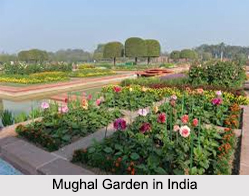 Architecture of Mughal Gardens in India depicts the influence of Arabian and Persian art work and architecture. The "charbagh" system here is flourished from the era of Babur. But later during the rule of Akbar, there lies a slightest change in the architecture of Mughal Gardens. The Mughal gardens are concentrated in India, Afghanistan, Bangladesh and Pakistan. In India, the Mughal gardens are concentrated in Jammu and Kashmir, Haryana, Punjab and Delhi. Some of the most beautifully maintained Mughal gardens in India are Taj Mahal Garden in Delhi, Presidential Gardens in Rashtrapati Bhavan, Delhi, Humayun"s Tomb Garden, Mehtab Bagh, Nishat Gardens in Jammu and Kashmir, Brindavan Gardens in Mysore, Shalimar Bagh in Srinagar, Jammu and Kashmir, Yadavindra Gardens in Haryana, Verinag Gardens in Jammu and Kashmir and Khusro Bagh in Allahabad, Uttar Pradesh.
Architecture of Mughal Gardens in India depicts the influence of Arabian and Persian art work and architecture. The "charbagh" system here is flourished from the era of Babur. But later during the rule of Akbar, there lies a slightest change in the architecture of Mughal Gardens. The Mughal gardens are concentrated in India, Afghanistan, Bangladesh and Pakistan. In India, the Mughal gardens are concentrated in Jammu and Kashmir, Haryana, Punjab and Delhi. Some of the most beautifully maintained Mughal gardens in India are Taj Mahal Garden in Delhi, Presidential Gardens in Rashtrapati Bhavan, Delhi, Humayun"s Tomb Garden, Mehtab Bagh, Nishat Gardens in Jammu and Kashmir, Brindavan Gardens in Mysore, Shalimar Bagh in Srinagar, Jammu and Kashmir, Yadavindra Gardens in Haryana, Verinag Gardens in Jammu and Kashmir and Khusro Bagh in Allahabad, Uttar Pradesh.
Design of Mughal Gardens in India
The Mughal gardens design derives primarily from the medieval Islamic garden, although there are nomadic influences that come from the Mughals" Turkish-Mongolian ancestry. The medieval Islamic garden is depicted as the walled off garden protected from the outside world; within, its design. These gardens were rigidly formal, and its inner space was filled with those elements that man finds most pleasing in nature.
Features of Mughal Gardens in India
The essential features of Mughal gardens in India included running water and a pool to reflect the beauties of sky and garden. The trees are of various sorts. Some of the tress are planted to provide shade merely, and others to produce fruits; flowers, colorful and sweet-smelling natural beauty. While the grass usually grew wild under the trees; birds to fill the garden with song and the whole garden is cooled by a pleasant breeze. The garden might include a raised mound at the center, the reminiscent of the mountain at the center of the universe in cosmological descriptions, and often surmounted by a pavilion or palace or a mausoleum.
Turkish Mongolian Element in Mughal Gardens in India
The Turkish-Mongolian elements of the Mughal garden are primarily related to the inclusion of tents, carpets and canopies reflecting nomadic roots. The tents indicated status in these societies, so wealth and power were displayed through the richness of the fabrics as well as by size and number.
Symbols and Motifs in Mughal Gardens in India
The Mughal rulers in India and their royal relatives were obsessed with symbol and incorporated it into their gardens in many ways. The standard Quranic references to paradise were in the architecture, layout, and in the choice of plant life; but more secular references, including numerological and zodiacal significances connected to family history or other cultural significance, were often juxtaposed. The numerological figures like the eight and nine were considered auspicious by the Mughal rulers and princes and can be found in the number of terraces or in garden architecture such as octagonal pools.



















